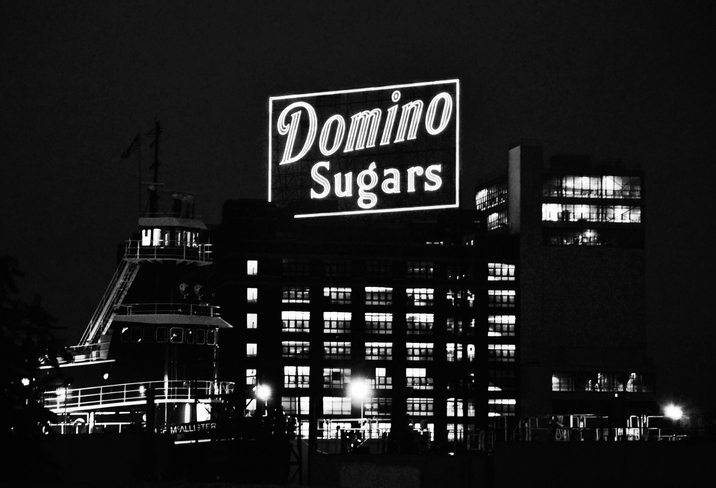
What types of businesses do you think might operate along Baltimore’s waterfront a century from today? The scale is hard to fathom-a semi-truck could drive through the hole in the “O.” This sign serves not only as a stunning local landmark but also a reminder that Domino Sugar still operates in its original location on the harbor. Triangle Signs installed and continues to maintain this South Baltimore landmark, visible from across the harbor. The red neon “Domino Sugars” sign was installed in 1951. The sugar processed here ends up at grocery stores as well as in the industrial kitchens of food suppliers. As of January 2020, the plant employed 485 workers and generated 125 related transportation jobs. Workers process approximately 6.5 million pounds of raw cane sugar each day, operating round-the-clock over three shifts Monday-Friday and 24/7 from September to January, when demand for sugar is higher.

ASR owns the Domino refineries in Locust Point as well as Yonkers, New York, and Chalmette, Louisiana they also own the leading West Coast brand C&H® Sugar, the Canadian brand Redpath®, the British brands Tate & Lyle® and Lyle’s® and Sidul® in Portugal. (ASR Group), based in Florida, acquired Domino Sugar in 2001. (ASR), a subsidiary of ASR Group International, Inc. The industry fell apart in the 1870s when a major importer of sugar and molasses declared bankruptcy.ĭomino® Sugar was first produced in New York in 1901 and received a trademark in 1906. This industry boomed between 1865-1873, when Baltimore’s rail system and shipping channels attracted six manufacturers to the area. The buildings remain largely unchanged, as they were a “monument of state-of-the-art modern industrial design” (according to its nomination to the National Register of Historic Places) a century ago.īaltimore was once home to six different sugar refineries, though only Domino remains. The 30-acre, 15-building campus was constructed in 1921 and opened for business in 1922. This South Baltimore site is the second largest sugar refinery in the U.S. Packaged and distributed via highways and railways, sugar produced in Baltimore travels to kitchens across the nation. Raw sugar arrives at the plant in giant ships and barges, and is unloaded and refined to become white, powdered, and brown sugar, as well as various liquid sugar products. In addition to Domino Sugar, American Sugar Refining (ASR Group) companies include C&H Sugar, Redpath Sugar (Canada), Tate & Lyle Sugars (UK), Sidul Acucares (Portugal), Belize Sugar Industries, Ingenio San Nicolas (Mexico), SRB (Italy) and Tellus Products.The Domino Sugar refinery (and its iconic red neon sign) is one of the last major working industries along Baltimore's inner harbor. 27 as the plant was brought back online after operations were halted as a precaution ahead of Hurricane Laura. That explosion was said to have been caused by a buildup of sugar dust and resulted in the total loss of the powdered sugar mill.ĭomino’s sugar refinery in Chalmette, La., was briefly closed last summer after a fire broke out in storage silos on Aug. In November 2007 an explosion and fire forced the Baltimore plant to shut down for about a week. Domino was in the midst of replacing the iconic rooftop Domino Sugars neon sign with an LED replica that was set to be unveiled July 4, according to local reports. The 99-year-old refinery employs 510 full-time workers and processes about 6.5 million lbs of raw cane sugar daily.

The cause of the fire is under investigation.”ĭomino’s Baltimore refinery is a major supplier of sugar to the Northeast. The refinery is currently not operating, and the fire department remains on the scene.

All employees are accounted for and no injuries occurred. “The Baltimore City Fire Department was immediately contacted, and the refinery was evacuated. on Tuesday,” Domino parent company American Sugar Refining Inc., said. “A fire in the raw sugar shed of the Baltimore refinery was reported at approximately 3 p.m.


 0 kommentar(er)
0 kommentar(er)
